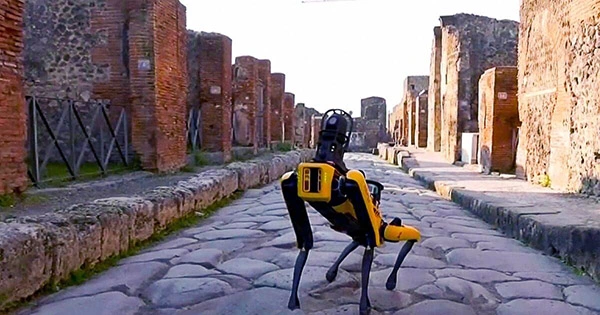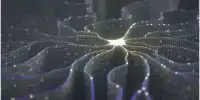According to tradition, a wolf laid the foundation for the Roman Empire. More than 2,700 years later, some of the civilization’s last and best-preserved relics still have a canine guardian — but with a very 21st-century twist. Spot, Boston Dynamics’ four-legged robot “dog,” is here to help. He’s recently started a new job, guarding the Pompeii ruins.
Spot was created in 2015 for search and rescue missions in areas that were too risky or inaccessible for people. He’s also exceptionally firm on his feet, especially on uneven or slippery terrain — a combination of skills that Pompeii officials feel makes the dog ideal for this new job. “Today, thanks to the collaboration with high-tech companies and in the wake of… successful experiments,” said Gabriel Zuchtriegel, Director General of Pompeii Archaeological Park, “we wish to test the use of these robots in the underground tunnels that were made by illegal excavators and that we are uncovering in the area around Pompeii.”
“The safety circumstances within the tunnels excavated by tomb robbers are sometimes highly perilous, as a result of which the deployment of a robot might represent a breakthrough that would allow us to go at a faster pace while being completely secure.” Spot isn’t the only high-tech instrument making its premiere at the old archeological site: park experts have previously been testing with the Leica BLK2FLY, a flying laser scanner capable of doing autonomous 3D scans, according to a press statement issued on Monday. Spot has his own autonomous laser scanner and a color camera with a 360-degree field of vision, but he can also be linked to the BLK2FLY to monitor the site as a group.
Spot and BLK2FLY are two of the first autonomous robots to be utilized at archeological sites. While “technological advances in the world of robotics… have produced solutions and innovations typically associated with the industrial and manufacturing world,” according to Zuchtriegel, “until now [they] had not found an application within archaeological sites due to the heterogeneity of environmental conditions, and the size of the site.”
Spot has his job cut out for him, with his new habitat comprising 66 hectares (163 acres) of old and hazardous ruins. But his appointment couldn’t come at a better time: while Pompeii remained unharmed for over two millennia after Mount Vesuvius erupted, in recent years the site has begun to succumb to an even deadlier foe than volcanoes: humanity. Pompeii was declared a state of emergency by the Italian government in 2008 due to tourism demands, climate change, and plain old-fashioned tombaroli – the local term for tomb robbers. The House of the Gladiators fell in 2010, bringing the site’s deteriorating health back into the spotlight, with opponents claiming that preservation efforts had been poorly managed.
By 2013, the situation had deteriorated to the point where Unesco threatened to put Pompeii to a list of endangered world heritage sites unless Italian authorities took action. Pompeii officials aim to discover an ultra-modern answer to preserve and protect this historic town with Spot and his aerial friend BLK2FLY.
“The goal of using innovative technological solutions is to improve both the quality of monitoring of existing areas and our knowledge of the state of progress of the works in those areas undergoing recovery or restoration, and thus to manage the site’s and workers’ safety,” park officials explained. “The project strives to a smart, sustainable, and inclusive administration of the Park, utilizing an integrated technology solution to make Pompeii a Smart Archaeological Park.”















